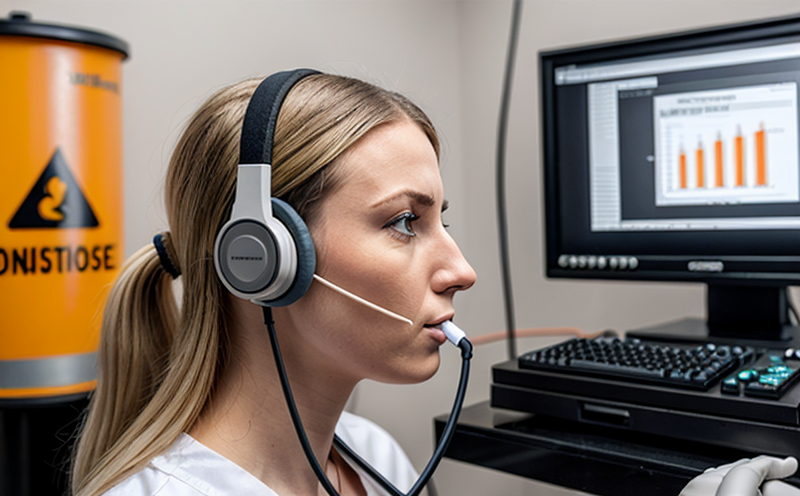ISO 11904-1 Sound Exposure in the Ear Canal Testing
The International Standard ISO 11904-1 provides a comprehensive framework for measuring sound exposure within the ear canal. This method is critical for assessing occupational noise exposure and ensuring compliance with international safety standards like OSHA (Occupational Safety and Health Administration) and EU directives aimed at protecting workers from hearing loss due to excessive noise levels.
The primary aim of ISO 11904-1 is to quantify the sound pressure level in decibels that reaches a worker's ear canal over time. This measurement helps in determining whether the noise environment complies with acceptable limits set by regulatory bodies such as the World Health Organization (WHO) and national health authorities.
The testing procedure involves placing a small, calibrated probe into the subject’s ear canal to measure sound exposure accurately. The probe captures the sound pressure levels over specified time intervals, which are then analyzed against predefined thresholds for acceptable noise levels in different occupational settings. This method ensures that employers can take necessary steps to mitigate harmful effects of excessive noise on their workforce.
Understanding and implementing ISO 11904-1 is essential for quality managers, compliance officers, R&D engineers, and procurement teams who are responsible for ensuring worker safety and compliance with international standards. By adhering to this standard, organizations can demonstrate a commitment to occupational health and safety while also avoiding potential legal issues associated with non-compliance.
The testing process typically involves several key steps:
- Identification of the specific noise sources in the workplace.
- Placement of the probe in the ear canal for a specified duration to capture sound levels.
- Data analysis using statistical methods to determine average and peak sound pressure levels.
- Evaluation against established occupational exposure limits (OELs).
Scope and Methodology
The scope of ISO 11904-1 encompasses the measurement of sound pressure levels in the ear canal of workers exposed to noise environments. The standard defines the procedures for placing calibrated probes into the ear canals, capturing data on sound exposure, and analyzing this information against established occupational exposure limits.
The methodology specifies that sound levels should be measured at various points throughout a typical workday, including during peak noise periods and quiet intervals. This approach ensures a comprehensive assessment of the overall noise environment experienced by workers. The standard also allows for the use of alternative measurement methods when specific conditions apply, such as in cases where direct ear canal measurements are not feasible.
Accurate data collection is crucial to ensure reliable results. Calibration of probes must be conducted regularly according to manufacturer specifications, and environmental factors that could affect sound levels (such as wind or temperature variations) should be controlled as much as possible during testing. Compliance with ISO 11904-1 ensures that the collected data can be trusted for making informed decisions about noise control measures.
For compliance officers responsible for ensuring worker safety, understanding these methodologies is essential. They must ensure that all equipment used meets the required standards and that tests are conducted under controlled conditions to yield valid results. This knowledge also helps in identifying areas where improvements can be made to reduce noise levels within the workplace.
Benefits
- Precise Measurement: Accurate measurement of sound exposure in the ear canal provides precise data on workers' actual noise exposure, facilitating better management and mitigation strategies.
- Compliance Assurance: Ensures adherence to regulatory requirements set by organizations like OSHA and EU directives, reducing the risk of legal actions and penalties for non-compliance.
- Improved Worker Safety: By identifying high-risk noise environments early, employers can implement effective measures to protect workers' hearing health.
- Cost Efficiency: Early detection of potential issues allows for targeted interventions, reducing costs associated with prolonged exposure and subsequent medical treatments.
- Data-Driven Decisions: Reliable data from ISO 11904-1 testing enables evidence-based decisions regarding noise control measures, leading to more efficient workplace designs.
Eurolab Advantages
EuroLab offers unparalleled expertise in ISO 11904-1 sound exposure testing. Our team of experienced professionals ensures that all tests are conducted according to the highest international standards, providing clients with accurate and reliable data they can trust.
Our facilities are equipped with state-of-the-art equipment designed specifically for ear canal testing, guaranteeing precise measurements even in challenging environments. We offer flexible scheduling options to accommodate busy work schedules without compromising on quality.
In addition to our technical capabilities, EuroLab prides itself on offering personalized service tailored to each client's unique needs. Our dedicated consultants are always available to provide guidance and support throughout the testing process, ensuring that every step is completed accurately and efficiently.
By choosing EuroLab for your ISO 11904-1 sound exposure tests, you gain access to a network of experienced professionals who understand the nuances of this critical standard. Whether you're looking to ensure compliance or improve worker safety, our services offer the expertise needed to achieve your goals.





